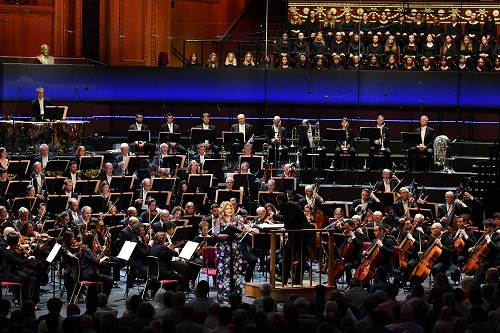
 United Kingdom BBC Prom 67 – Mahler: Susan Graham (mezzo-soprano), City of Birmingham Symphony Youth Chorus and Chorus (female voices), Boston Symphony Orchestra / Andris Nelsons (conductor). Royal Albert Hall, London, 2.9.2018. (JPr)
United Kingdom BBC Prom 67 – Mahler: Susan Graham (mezzo-soprano), City of Birmingham Symphony Youth Chorus and Chorus (female voices), Boston Symphony Orchestra / Andris Nelsons (conductor). Royal Albert Hall, London, 2.9.2018. (JPr)

Mahler – Symphony No.3 in D minor
After appearing in the 2014 and 2016 Proms seasons it was time for Mahler’s Third Symphony once again. The first thing to remark is how the Proms audience can be a continuing source of merriment. As I sat down, I overheard, ‘Oh good, we are close of the end of the row and I’ll be able to get out quickly at the interval for a drink’. At least there was little coughing and no applause between the movements until Susan Graham entered just before the fourth movement.
To be honest this concert was good – but not in any way memorable – and seemed to be suffering from the relatively early hour (2pm) for playing Mahler and possibly some jetlag, the Boston Symphony Orchestra, having I guess, flown in the day before on the first leg of a two-week European Tour that will take in Germany, Austria, Switzerland, France and The Netherlands, after the Proms. Unless it was my ears, there was some minor insecurity from the brass particularly.
Mahler considered giving his Third Symphony a title, perhaps Pan after the Greek god of nature, or Die fröhliche Wissenschaft (The Joyful Science), after one of Friedrich Nietzsche’s philosophical works. Ultimately the composer decided his audiences did not need to know anything about what inspired his music. The first movement is approximately one-third of the entire symphony and one of the largest single movements anywhere: it is also one of the most original and daring in the variety of music it contains. The opening theme for eight horns, might well be a child’s song. It is followed by a panoramic view of a great landscape and then ‘Summer marches in’ from a distance. The next four movements are relatively brief character pieces depicting flowers, animals, people, and angels. The second movement, the flower minuet, includes music that previews ‘Das himmlische Leben’ (‘Heavenly Life’) which was to end the movement in Mahler’s original seven-movement concept, but belongs now to the Fourth Symphony. The third movement, a kind of scherzo, is an orchestral version of the setting of ‘Ablösung im Sommer’ (‘Relief in summer’), a Wunderhorn song. There are two trios, first a vision of birds and beasts playing; the second a still summer day, disturbed only by a distant posthorn. The movement ends with a great eruption of sound, as if Pan has arrived to transform the world of birds and animals. The fourth movement introduces the sound of the human voice, a setting of ‘Midnight Song’ from Nietzsche’s Also sprach Zarathustra. The fifth movement follows without any pause, shifting from the hush of midnight to the bright sounds of angels and morning bells. This text also comes from Des Knaben Wunderhorn. The voices are those of women’s chorus, children, and soloist; the violins are silent throughout. Again, we recall ‘Heavenly Life’.
The final movement doesn’t need description. It is marked ‘Slow. Peaceful. With feeling’. Mahler told his then lover, Anna von Mildenburg, it reminded him of the motto: ‘Father, see these wounds of mine! Let no creature of yours be lost!’. Nobody who hears this symphony after – as I have – hearing Parsifal at Bayreuth, can fail to recognise how Mahler was inspired by that opera, particularly here in this slow movement. It is so reminiscent of Wagner’s Act III Prelude; has music equally as moving and powerful and Andris Nelsons and his musicians did it full justice. Several musicologists and many conductors still ignore Wagner’s influence on Mahler at their peril though, I believe, Nelsons did ‘know’ what he was conducting, and you could marvel at the Wagnerian colours he drew out from the orchestra at the expense of what, I suspect, Mahler wanted us to hear from his music. As the Adagio finale unfolded towards its Schopenhauerian conclusion – where both the world and its earthly love is renounced – the lower strings recall Parsifal (also the fifth movement ‘bells’ cannot be a coincidence?) and the upper ones Lohengrin. This was all made the more poignant if you recall the words of the 1930s’ song ‘I’ll Be Seeing You’ – its composer, Sammy Fain, probably lifted the tune’s first four lines from this last movement. (That song was the anthem for British and American soldiers in World War II and Liberace’s theme music.) Stephen Johnson is an esteemed musicologist; he can read music (I can’t) but can he hear it? His rehashed programme notes for the Third Symphony mentioned neither Wagner nor the Fain connection (noted by Deryck Cooke, and others including me).
Andris Nelsons regularly checked his score, and this cannot have helped his interpretation. It was cliché free and, sorry, a bit bland. In ‘Summer marches in’ I would have liked greater Dionysian turmoil in the episodic mix of primordial or pastoral sounds and for the orchestra to be ‘let off the leash’ more here – and elsewhere – for the raucous military music, especially. It was all as if the orchestra never wanted to sound (deliberately) ugly or sardonic. The ‘flowers’ movement had great charm and wistful nostalgia. Despite not all being on top form there had already been some amazing virtuosity from members of the Boston Symphony Orchestra and there continued to be some fine solo contributions from section principals and especially ‘concert-master’, Tamara Smirnova. The posthorn (Thomas Rolfs’ flugelhorn) was insufficiently otherworldly during the third movement and too much like the ‘Last Post’. This should have been played from the upper reaches of the Royal Albert Hall.
One of the world’s great mezzo-sopranos, Susan Graham, was ‘luxury casting’ for an intense ‘O Mensch, gib Acht!’. Diction was clear and it all was immaculately phrased, but I never felt the ‘anguish’ or ‘pain’ inherent in this passage and anyway she sounded more like ‘just’ a soprano. The screech of the night-bird called out, though the hinaufziehen (‘pull up’) instruction for the oboist sounded as if it had been ignored. The female voices of the City of Birmingham Chorus and those of the CBSO Youth Chorus were clearly well-schooled and fulfilled their brief duties with focused energy. However, I missed the ‘innocence’ of a children’s choir giving us rather more angelic ‘Bimm, bamms’!
In conclusion, Nelsons had initially made a long symphony even longer but towards the end gave us a yearning, prayerful melody that was almost – but not quite – so overwhelming in its emotional power as to transcend the longueurs and weaknesses earlier in the performance. Nevertheless, it earned all the performers an immediate, well-deserved ovation.
Jim Pritchard